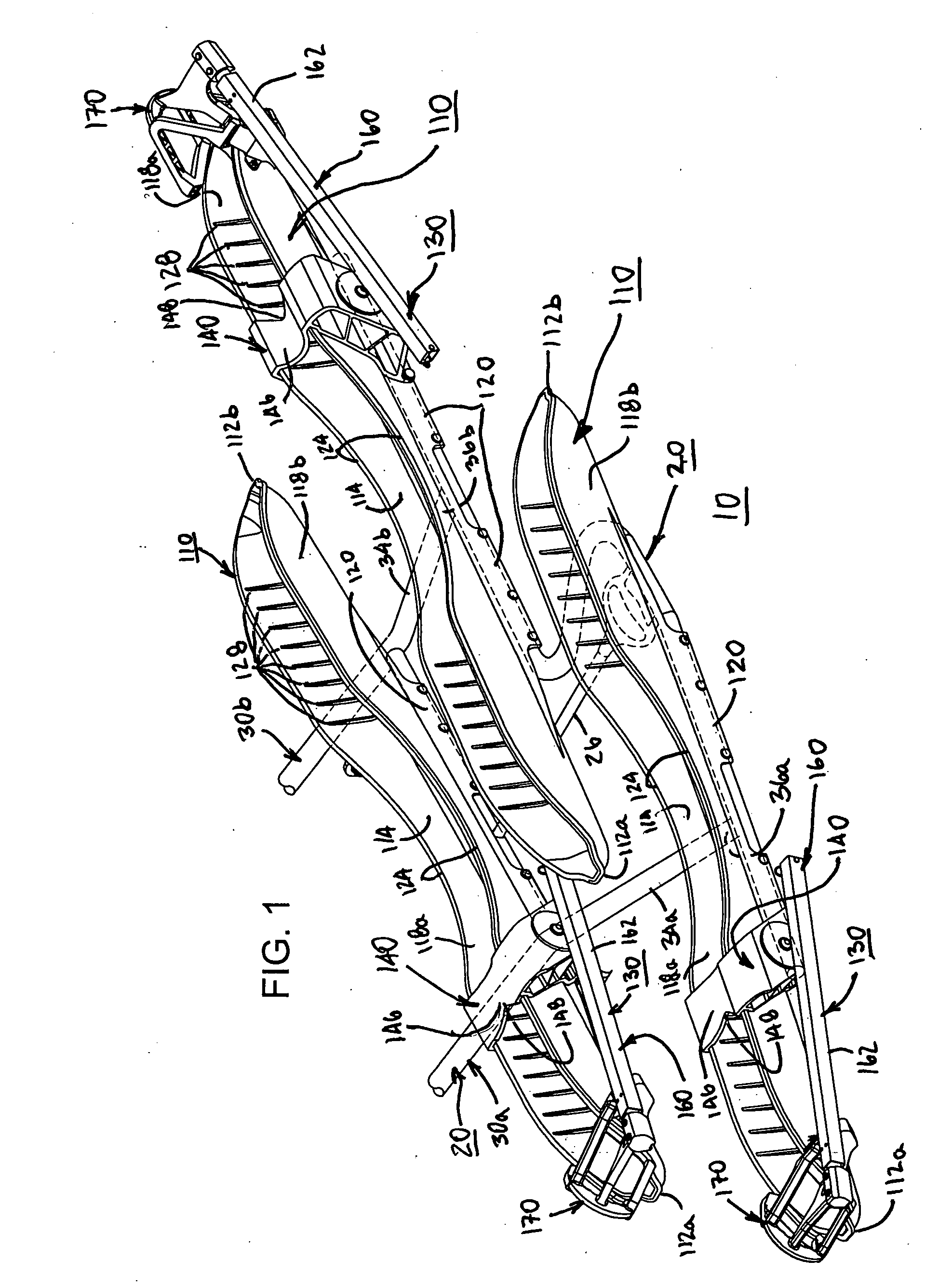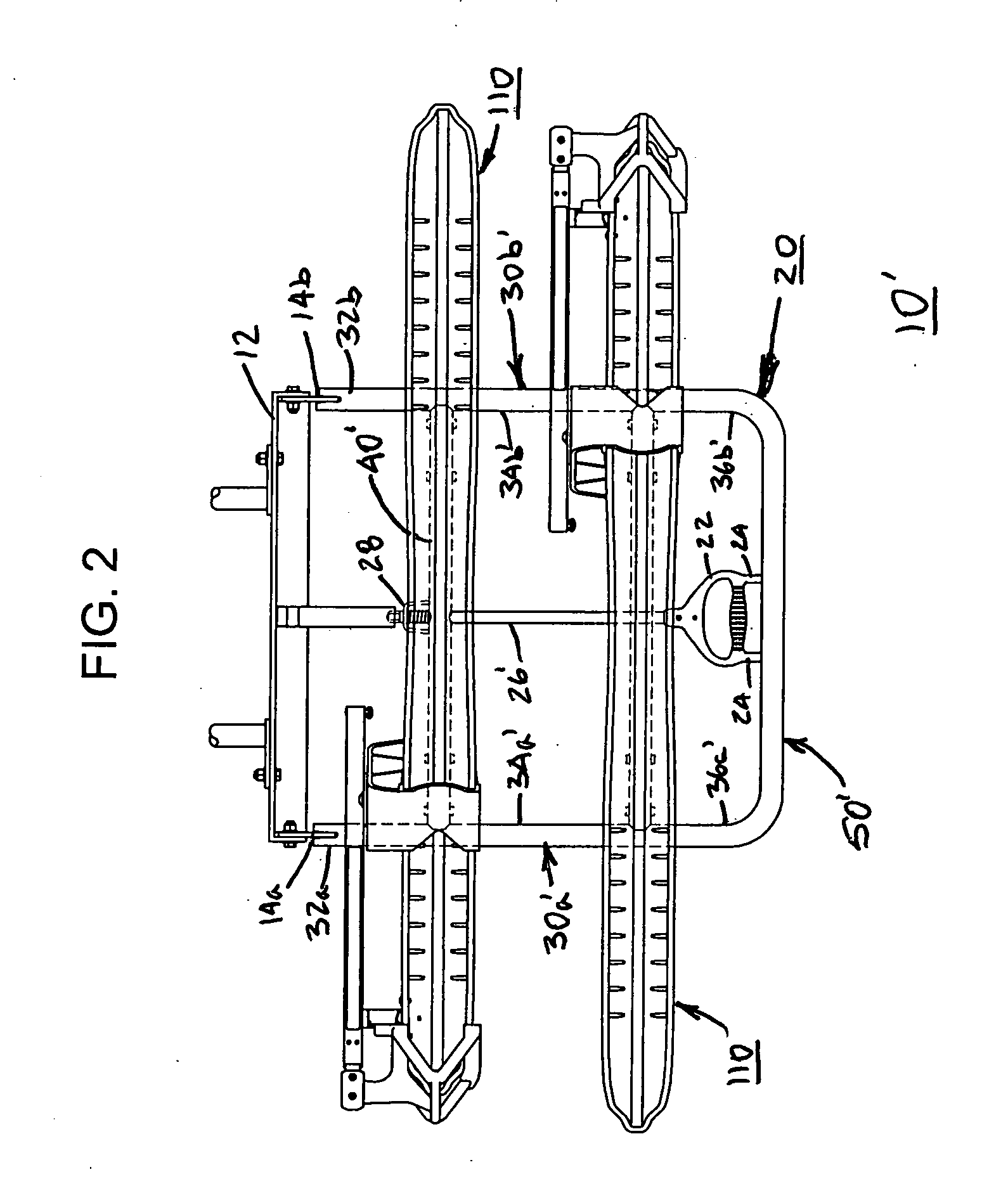[0006]Each tray embodiment according to the invention may be configured to receive one or multiple tires of a cycle; preferred embodiments provide single trays configured to receive two tires. Furthermore, while the resiliency of the trays according to the invention is greater than that of the frame structural components, and thus is material non-specific, preferred embodiments are constructed from non-
metallic materials such as
fiber reinforced thermosetting (injection) plastics or thermoformed plastics, which provide the desired levels of performance.
[0008]As previously noted, preferred tray embodiments of the invention may utilize polymeric materials to provide the desired level of performance. In particular, the trays are characterized as resilient, and particularly so over the
working range of the anticipated installation. Possessing such qualifications, preferred embodiments of the tire tray
resist damage from small impacts that occur during use of the vehicle or
system, minimizes damage to objects that
impact the tray(s) (persons or property) or are impacted by the tray(s) (front
mask of the vehicle). Preferred embodiments of the invention have a
flexural modulus of between about 40 KSI and 120 KSI throughout the operation range of the installation, and additionally are not subject to
brittle fracture at about −40° C.
Material selection, such as thermosetting materials using
reaction injection molding, ensure such properties for optimal performance while design geometries enhances
load bearing as well as
impact deflection properties. The trays need not be constructed from a homogenous material, but may represent
hybrid structures both in overall composition, e.g., glass mat and resin, and / or discrete structure, e.g., steel spanning structure mounted to the frame with opposing wheel trays, one for each tire, constructed from a
polymer.
[0009]The use of a non-
metal (particularly non-steel) tire trays significantly lightens the overall
system, thereby decreasing stress at the vehicle mounting interface, provides a
corrosion resistant
system when used in conjunction with stainless
steel frame components and stainless steel fasteners, and in the case of
polymer constructed trays, requires no “repair” if reasonably impacted. In many preferred embodiments, a single tire tray having two tire wells weigh approximately 2.5 Kg (5.6 lbs.).
[0011]Mounting flanges may extend from the longitudinal members at the proximal ends thereof or from any cross member positioned adjacent to the proximal ends, and are adapted to engage with a target vehicle, such as a public transit vehicle having a complementary linkage. An assist spring may be used to impart an “upward” or stowed
position bias to the frame, thus decreasing the degree of effort a user must exert in order to stow the frame, as is common in most applications. The frame may also comprise a latching
assembly to retain the frame in a stowed position and / or a deployed position, as is also common in most applications.
[0014]Further frame embodiments of the invention provide means for establishing a greater number of tire receiving means than the number of transverse frame members, e.g., the first and second cross members. In these embodiments, a single cross member may be longitudinally offset over the lateral direction so that two tire receiving means can be accepted or integrated by or into a single cross member or other laterally extending member. It therefore becomes apparent that the same basic support frame used for two cycle portage applications can be modified through the simple addition or substitution (or
adaptation) of a cross member and be transformed into a three cycle portage apparatus. Moreover, if the tire receiving means are removable from the supporting structure, the location of the tire receiving means may be selectable by the user within certain parameters, thus permitting the user to optimally configure the system for a particular use or fitment, e.g., location of headlights and / or turn signals of the equipped vehicle.
[0015]In addition to the foregoing, frame embodiments of the invention may comprises at least one wheel retention
assembly for selectively retaining therein a cycle tire that is placed in the tire receiving means. The wheel retention
assembly includes a wheel clamp arm, tire jaw (with or without variable tire width
accommodation means such as dual contacting surfaces and / or dual channels) and an optional mounting interface. The wheel clamp arm is preferably rotationally mounted either directly or indirectly (via the mounting interface) to the frame, thus providing both flexibility in use by accommodating cycles having disparate wheel diameters as well as efficient
stowage when not in use. In one series of embodiments, a mounting interface selectively engages the frame and further provides a pivotal connection location for the support arm. Through this arrangement, a robust linkage between the wheel clamp arm and the frame can be achieved, and in embodiments where the mounting interface engages with the tire receiving means, the mounting interface can also act as a tire chock.
 Login to View More
Login to View More  Login to View More
Login to View More 


